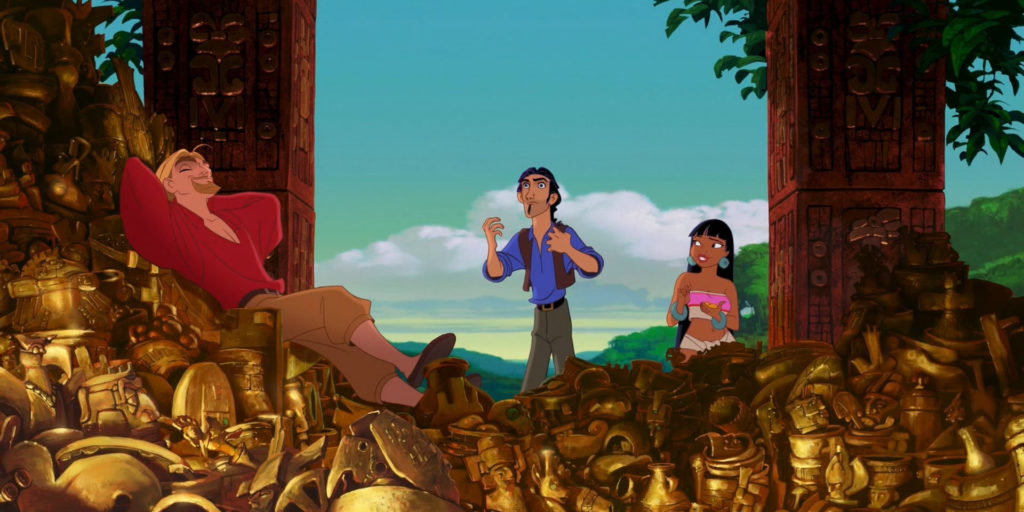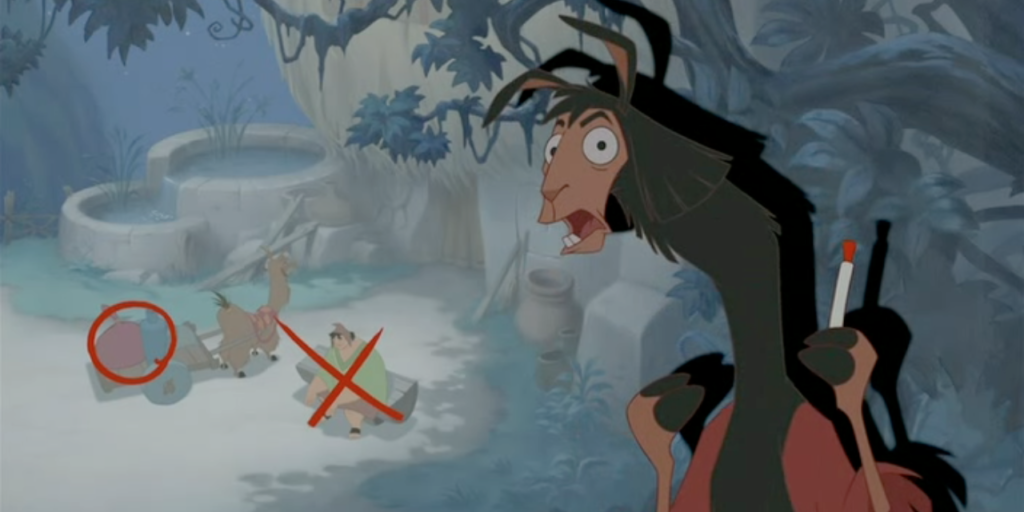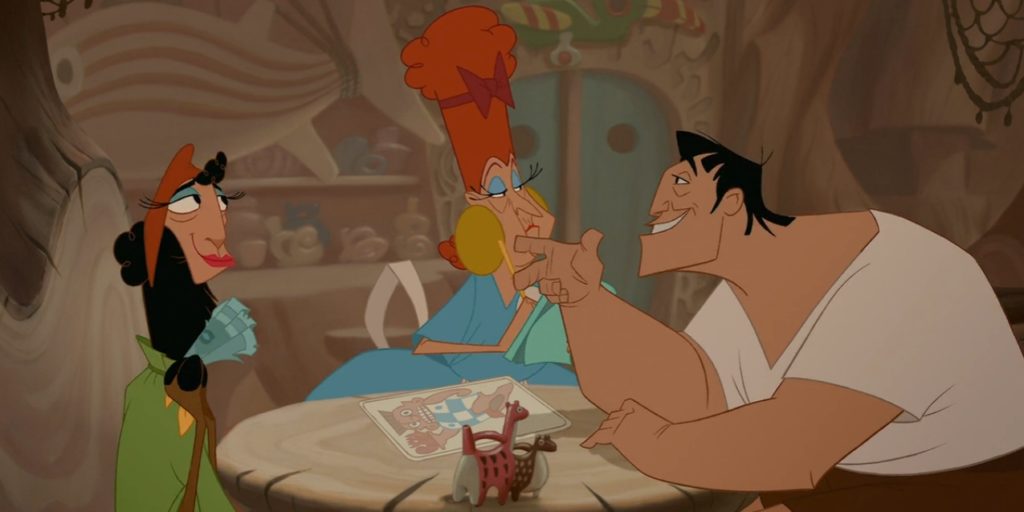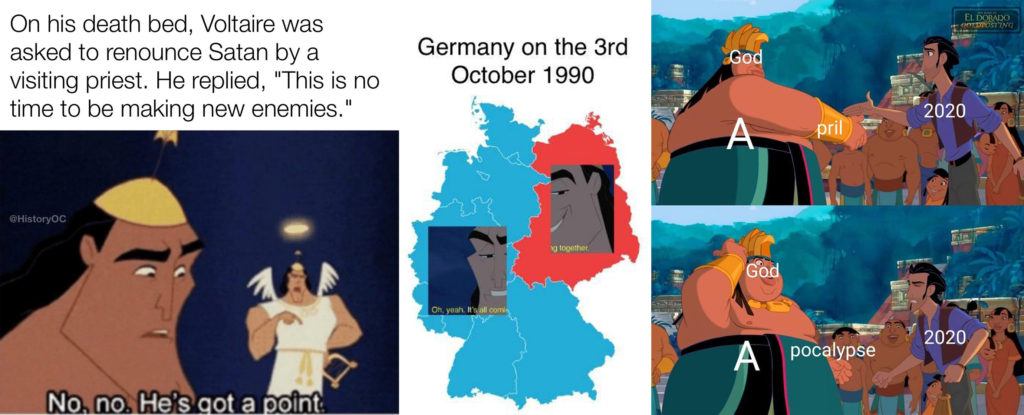Hisorical Reviews of the Road to El Dorado
History is oft complicated by nostalgia. The prevalence of meme culture within online discourse accentuates the inextricable relationship between the two, especially when enough time has passed for a media text to resurge in popularity. Take, as 2 examples, a double bill of films released at the dawn of the millennium: The Emperor's New Groove and The Road to El Dorado. Celebrating their twentieth anniversaries, these films from Disney and DreamWorks, respectively, emerged in a landscape where mainstream American animated films faced a crisis of identity following the end of the Disney Renaissance era. Informed by Southward and Latin American aesthetics, both films heralded the futurity more than clearly than their box office performances might indicate by capturing a past rooted less in Mesoamerican or Incan mythology than the one-act of Looney Tunes and the Hope/Crosby Road To… movies. Indeed, it is the eschewing of both cultural and historical verisimilitude which makes the transfiguration of these films into reaction gifs seem similar a foregone conclusion.
As noted, New Groove and El Dorado have a surprising amount in mutual. Aside from their aesthetic similarities, both films were in evolution roughly during the same menstruation of six years and gradually transitioned from beingness epic in telescopic to more than farcical in nature. In a frank interview on the prolonged product process of the DreamWorks film, co-writer Ted Elliott described the protagonists, a couple of 16th Century Spanish swindlers (voiced by the emphatically non-Spanish actors Kevin Kline and Kenneth Branagh) every bit "more Butch and Sundance than Bob and Bing" in the original draft scripted by him and Terry Rossio. Both writers were fresh off the success of Aladdin when Disney CEO Jeffrey Katzenberg gifted them a copy of Hugh Thomas' Conquest: Montezuma, Cortes and the Fall of Old Mexico, hoping to make a film from the material after leaving Disney. The premise of the film, of two stowaways who wash up on the shore of the New World and find the eponymous lost city of gilt, remained fundamentally identical to its finished form, yet Elliot and Rossio's original script was purportedly more than ambivalent, undercutting its adventurous spirit with the impending inflow of Hernán Cortés (played in the motion picture by Jim Cummings). Every bit Elliott put it, their version looked similar an animated iteration of David O. Russell's Three Kings, simply with Elton John showtunes.

Withal, in that location remains an uneasy balance between pathos and slapstick in the final version, particularly when Miguel and Tulio finally stumble upon the urban center and pose as deities returned from the heavens. Stabs at social commentary on institutional organized religion manifest in the dynamic between the chivalrous Chief Tannabok (Edward James Olmos) and the fanatical loftier priest Tzekel-Kan (Armand Assante). The latter'due south predilection toward homo cede is greeted with grim dismay from the people, though his sway over the social order of the city is never fully developed. This is partially due to the story'southward structural mistake of rendering most of the citizens as a nameless, homogenous entity around which things happen to nevertheless are rarely instigated by. Indeed, the sole indigenous effigy who retains a relatively circuitous characterization is the chief, whose ain rivalry with Tzekel-Kan gestures toward a nuanced political dialectic between fundamentalism and liberalism. It is the question of fallibility complementing, rather than undermining, ethical responsibility in roles of leadership which provide the motion picture its strongest moments, including the realization from both leaders that the visiting Spaniards are anything but divine. Tannabok'south revelation of Miguel's subterfuge through a citation of an Alexander Pope quote the latter invoked earlier comes closest toward articulating the film's thesis in a wry, genuinely poignant fashion.
The lesson imparted in this scene echoes the pitch Roger Allers presented to Disney of a film nearly "a mutual man educational activity an arrogant man how to rule". His tale was called Kingdom of the Dominicus, a parable set up during the pinnacle of the Incan Empire about a peasant who switches roles with an arrogant autocrat. The film was intended to comprise elements of Incan mythology, notably Viracocha, in its dramatization of a struggle between the peasant/emperor and an evil counselor who seeks to extinguish the sun for vanity's sake. Weaving these components together would be a musical score written by Sting, populated by an all-star cast.

To recount the troubled production of what would go The Emperor's New Groove would fill an entire article, and indeed yous'd be ameliorate off watching Trudie Styler's The Sweatbox (if you can notice it; Disney owns the rights but has refused giving it an official release), which chronicled the tumultuous transition from Allers to Mark Dindal as manager. Dindal's 1997 animated musical throwback Cats Don't Dance painted Hollywood'due south Golden Age with rosy-colored popular-out glasses, like a pint-sized Gene Kelly on a sugar rush. It was that vein of elasticity which Dindal brought to New Groove, something a coiffure member succinctly likened to "an Incan version of Las Vegas" (this description is but reinforced by an inexplicable Tom Jones cameo). Indeed, New Groove ping-pongs through vaguely recognizable staples of Americana processed through a Rube Goldberg car. When it was unleashed upon the world in time for Christmas, The Emperor's New Groove didn't resemble the traditional Disney model so much as information technology did something like Chuck Jones' Duck Amok and Joe Dante'due south Gremlins two: The New Batch in its anarchic, metatextual aplomb. For antsy child audiences (including yours truly), it provided empty-headed nirvana.

If The Emperor's New Groove excelled in extolling the virtues of anachronism, its ultimate conventionality betrayed its more daring flourishes. The story is simple to the point of perfunctory, wherein the titular monarch (David Spade) is taught humility by a kindly and patient peasant (John Goodman) every bit they are pursued by his evil advisor and her bumbling lackey (Eartha Kitt and Patrick Warburton, who handily steal the show), nevertheless the picture show's greatest oversight is its coincidental deracination. Any references toward Incan mythology in the film'due south before incarnation are at present gone, and arguably more glaring is the total absence of a single Latinx performer within the cast. Disney's troubled legacy with various representation has yielded more than egregious examples, yet the release of Lilo & Sew together eighteen months later only emphasized more pointedly the antiquated elements of New Groove. Dindal's exclamation that "you lot tin can't be making this farce almost a specific group of people unless we are going to poke fun at ourselves" is well-intentioned, nevertheless the film'south omission of anyone from this very customs has the unfortunate implication that such tales of representation cannot simultaneously implement culturally specific comedy.
The mixture of one-act and desolation in El Dorado arguably makes that motion picture more distinctly intriguing, if no more successful. The moving picture strives for greater diverse casting with Olmos every bit the Chief and Rosie Perez as Chel, all the same the latter ultimately functions every bit a plot device which threatens the friendship of the main duo. As the simply female graphic symbol in the film, her sexuality stands out even more equally a weaponized asset utilized for self-preservation, at least until the promise of a character arc becomes subsumed by Miguel and Tulio'southward own spat over godhood. The overriding theme of male person esprit in both films cement heteronormative stereotypes, even as New Groove attempts to undermine a strict gender binary through comic scenarios involving homoeroticism. These instances resemble the comic effect of Bugs Bunny's use of elevate and, at worst, reinforce toxic tropes of male discomfort with intimacy, as is evident in an instant of attempted oral cavity-to-oral fissure resuscitation.

El Dorado forgoes explicit displays of queerness, though a subset of its fanbase has expanded subtextual traces of homoeroticism by aircraft its main duo. Yet the picture's apex of masculine camaraderie is unfortunately epitomized in a climatic example approximating a White Savior complex when Miguel sacrifices staying with the natives for the sake of saving them. Their story is ceded to a narrative which culminates in the shot of Miguel soaring through the air in an actualization of the vision of the Gods the chief alluded toward earlier. Miguel (and by proxy Tulio) redeem themselves through the benevolent deed of sparing a customs, yet past ultimately sidestepping complex ambivalence, the film effectively rewrites history's tragic outcome for the hope of farther adventures which sustain the spirit of colonialism whilst eliding its roughshod consequences on indigenous peoples.
Having said all this, to attribute the popularity of these films within a digital discourse to mere nostalgia would ignore their qualities as cult movies. In their ain peculiar (dis)engagement with history, both The Road to El Dorado and The Emperor's New Groove communicate less almost the moments in which their stories are set than they do the fourth dimension in which they were released. They are films that, nostalgia notwithstanding, tin be argued as ones which tentatively prodded the commercial constraints foisted upon them with comic panache and expressionistic, occasionally striking ready pieces to ultimately serve as role of a greater memetic terrain 20 years later, i where history is processed in yet another dissonant manner.

The pop-infused abrasiveness perfected by Shrek was still a yr abroad, and the young audiences who flocked to these films were seeking something that was familiar yet new, stories that deflated the solemnity of flatulent musicals while gently guiding the states into a new, unknown millennium with traces of the old. Like the sickly boy being read The Princess Helpmate, perhaps the clearest progenitor to many of these movies, we wanted something different yet comforting in the pleasures provided by generic familiarity. That neither The Route to El Dorado nor The Emperor'due south New Groove is entirely successful as subversive texts does zippo to diminish their growing stature as visually striking comedic curios among cultists of a certain age. Afterward all, every bit Mr. Pope understood information technology centuries ago, to err is human being.
Source: http://www.kouhifilms.com/2020/04/24/cults-of-personality-the-road-to-el-dorado-and-the-emperors-new-groove-at-20/
0 Response to "Hisorical Reviews of the Road to El Dorado"
إرسال تعليق